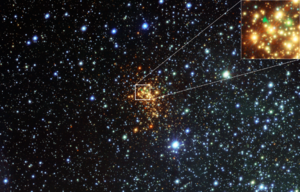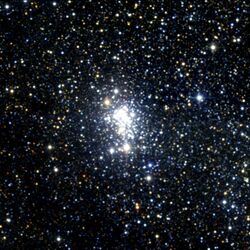Astronomy:Westerlund 1-26
Coordinates: ![]() 16h 47m 05.40s, −45° 50′ 36.76″
16h 47m 05.40s, −45° 50′ 36.76″
| Observation data Equinox J2000.0]] (ICRS) | |
|---|---|
| Constellation | Ara |
| Right ascension | 16h 47m 05.403s[1] |
| Declination | −45° 50′ 36.76″[1] |
| Apparent magnitude (V) | 17.194[2] |
| Characteristics | |
| Spectral type | M0.5–M6[3] (M2-M6Ia[4]) |
| Apparent magnitude (B) | 22.1[5] |
| Apparent magnitude (J) | 4.31[1] |
| Apparent magnitude (H) | 1.35[1] |
| Apparent magnitude (K) | 1.9[6] |
| B−V color index | +4.906[2][5] |
| Astrometry | |
| Radial velocity (Rv) | -49.42 km/s |
| Proper motion (μ) | RA: -1.841[7] mas/yr Dec.: -3.909[7] mas/yr |
| Parallax (π) | 0.0534 ± 0.0917[7] mas |
| Distance | 11,500 ly (3,550[8] pc) |
| Details | |
| Radius | 1,165 ± 58 or 1,221 ± 120[3] R☉ |
| Luminosity | 256,000 ± 40,000 or 312,000 ± 37,000[3] L☉ |
| Temperature | 3,720 ± 183 or 4,000 ± 100[3] K |
| Age | 7.9[3] Myr |
| Other designations | |
Westerlund 1 W26, 2MASS J16470540-4550367, Westerlund 1 BKS AS, Westerlund 1 BKS A, Gaia EDR3 5940106041452150272 | |
| Database references | |
| SIMBAD | data |
Westerlund 1-26 or Wd 1-26 is a red supergiant within the outskirts of the Westerlund 1 super star cluster. It is one of the largest known stars discovered so far although its radius is uncertain but is calculated to be 1,165–1,221 solar radii (810,000,000–849,000,000 km; 5.42–5.68 astronomical unit|au), with a possible but very unlikely upper estimate of 2,519 solar radii (1.752×109 km; 11.71 astronomical unit|au), corresponding to a volume between 1.58 and 16 billion times bigger than the Sun. Assuming the upper estimate is correct, if placed at the center of the Solar System, its photosphere would engulf the orbit of Jupiter.
Discovery
Westerlund 1 was discovered by Bengt Westerlund in 1961 during an infrared survey in the Zone of Avoidance of the sky, and described as "a heavily reddened cluster in Ara". The spectral types of the component stars could not be determined at the time except for the brightest star which was tentatively considered type M.[9][10]
In 1969, Borgman, Kornneef, and Slingerland conducted a photometric survey of the cluster and assigned letters to the stars they measured. This star, identified as a strong radio source, was given the letter "A".[11] This leads to the designation Westerlund-1 BKS A as used by Simbad, although the cluster was not known as Westerlund 1 at that time. At the time it was referred to as Ara A, with another strong radio source in the cluster called Ara C. Its brightness in the radio spectrum makes it one of the rare "radio stars". Westerlund made spectroscopic observations of the cluster, still not known as Westerlund 1, published in 1987 and numbered the stars, giving the number 26 and the spectral type M2I.[10] Westerlund also discovered another notable red supergiant, WOH G64, found in the Large Magellanic Cloud in the constellation Dorado.
Modern terminology stems from 1998 when the cluster was referred to as Westerlund 1 (Wd1), with a paper describing Ara A as star 26 and Ara C as star 9.[12]
Physical characteristics
Westerlund 1-26 is classified as a luminous cool supergiant. It occupies the upper right corner of the Hertzsprung–Russell diagram. The cool temperature means it emits a significant part of its energy in the infrared spectrum. It also shows huge mass loss of atmospheric material, suggesting that it may further evolve into a hotter supergiant. Westerlund 1-26 has been observed to change its spectral class (and thus its temperature) during several periods, but it has not been seen to change its luminosity.[8]
The star is almost obscured at visible wavelengths by extinction of around 13 magnitudes due to interstellar dust,[2] hence it has been studied extensively in the longer infrared to radio wavelengths, which made it easier to study. Its spectral type identifies it a red star with a high luminosity. The bolometric luminosity of Westerlund 1-26 has been calculated from its K-band infrared brightness to be between 320,000 and 380,000 times higher than the sun's (L☉), depending on the spectral type between M2 and M5. These luminosities imply a radius between 1,530 and 1,580 times the Sun's radius (R☉)[8] based on effective temperatures of 3,450 and 3,660 K for spectral types M5 and M2 respectively.[13][8] These parameters make Westerlund 1-26 one of most luminous red supergiants and are similar to those estimated for another notable red supergiant star, VY Canis Majoris.[8] An earlier calculation of the luminosity and the temperature by fitting the spectral energy distribution and based on the spectrum by using DUSTY model gave a far higher luminosity near 1,100,000 L☉, considerably more luminous than expected for a red supergiant. The model also gave a photospheric temperature of 3,700 K, corresponding to a radius of 2,519 R☉.[14][lower-alpha 1]
In October 2013, astronomers using the European Southern Observatory's Very Large Survey Telescope (VST) discovered that Westerlund 1-26 is surrounded by a glowing cloud of ionized hydrogen. This is the first ionized nebula to have been discovered around a red supergiant star through its optical emission lines, and follows the discovery of an ionized nebula around NML Cyg in 1982.[15][16] The nebula extends 1.30 parsecs from the star.[citation needed] The nebulae of both Westerlund 1-20 and Westerlund 1-26 are extended outward from the cluster core and most bright at inward direction, indicating the outward cluster wind.[17] A later study analyzed the ejecta surrounding some of Westerlund 1's stars; the study determined the mass of Westerlund 1-26's ejecta to be 403×10−3 M☉, with an uncertainty of ± 94×10−3 M☉.[18]
See also
Notes
- ↑ Applying the Stefan-Boltzmann Law with a nominal solar effective temperature of 5,772 K: [math]\displaystyle{ \sqrt{(5,772/3,700)^4 * 10^{6.03}} = 2,519.12\ R\odot }[/math]
References
- ↑ 1.0 1.1 1.2 1.3 Cutri, Roc M.; Skrutskie, Michael F.; Van Dyk, Schuyler D.; Beichman, Charles A.; Carpenter, John M.; Chester, Thomas; Cambresy, Laurent; Evans, Tracey E. et al. (2003). "VizieR Online Data Catalog: 2MASS All-Sky Catalog of Point Sources (Cutri+ 2003)". CDS/ADC Collection of Electronic Catalogues 2246: II/246. Bibcode: 2003yCat.2246....0C. http://vizier.u-strasbg.fr/viz-bin/VizieR?-source=II/246.
- ↑ 2.0 2.1 2.2 Lim, Beomdu; Chun, Moo-Young; Sung, Hwankyung; Park, Byeong-Gon; Lee, Jae-Joon; Sohn, Sangmo T.; Hur, Hyeonoh; Bessell, Michael S. (2013). "The Starburst Cluster Westerlund 1: The Initial Mass Function and Mass Segregation". The Astronomical Journal 145 (2): 46. doi:10.1088/0004-6256/145/2/46. Bibcode: 2013AJ....145...46L.
- ↑ 3.0 3.1 3.2 3.3 3.4 Arévalo, Aura (2019). The Red Supergiants in the Supermassive Stellar Cluster Westerlund 1 (Thesis). doi:10.11606/D.14.2019.tde-12092018-161841.
- ↑ Clark, J. S.; Ritchie, B. W.; Negueruela, I.; Crowther, P. A.; Damineli, A.; Jablonski, F. J.; Langer, N. (2011). "A VLT/FLAMES survey for massive binaries in Westerlund 1". Astronomy & Astrophysics 531: A28. doi:10.1051/0004-6361/201116990. Bibcode: 2011A&A...531A..28C. http://oro.open.ac.uk/30687/1/1105.0776v1.pdf.
- ↑ 5.0 5.1 Clark, J. S.; Negueruela, I.; Crowther, P. A.; Goodwin, S. P. (2005). "On the massive stellar population of the super star cluster Westerlund 1". Astronomy and Astrophysics 434 (3): 949. doi:10.1051/0004-6361:20042413. Bibcode: 2005A&A...434..949C.
- ↑ Piatti, A. E.; Bica, E.; Claria, J. J. (1998). "Fundamental parameters of the highly reddened young open clusters Westerlund 1 and 2". Astronomy and Astrophysics Supplement 127 (3): 423. doi:10.1051/aas:1998111. Bibcode: 1998A&AS..127..423P.
- ↑ 7.0 7.1 7.2 Brown, A. G. A. (2021). "Gaia Early Data Release 3: Summary of the contents and survey properties". Astronomy & Astrophysics 649: A1. doi:10.1051/0004-6361/202039657. Bibcode: 2021A&A...649A...1G. Gaia EDR3 record for this source at VizieR.
- ↑ 8.0 8.1 8.2 8.3 8.4 Wright, N. J.; Wesson, R.; Drew, J. E.; Barentsen, G.; Barlow, M. J.; Walsh, J. R.; Zijlstra, A.; Drake, J. J. et al. (16 October 2013). "The ionized nebula surrounding the red supergiant W26 in Westerlund 1". Monthly Notices of the Royal Astronomical Society: Letters 437 (1): L1–L5. doi:10.1093/mnrasl/slt127. Bibcode: 2014MNRAS.437L...1W.
- ↑ Westerlund, Bengt (1961). "A Heavily Reddened Cluster in ARA". Publications of the Astronomical Society of the Pacific 73 (430): 51. doi:10.1086/127618. Bibcode: 1961PASP...73...51W.
- ↑ 10.0 10.1 Westerlund, B. E. (1987). "Photometry and spectroscopy of stars in the region of a highly reddened cluster in ARA". Astronomy and Astrophysics Supplement Series 70: 311. ISSN 0365-0138. Bibcode: 1987A&AS...70..311W.
- ↑ Borgman, J.; Koornneef, J.; Slingerland, J. (1970). "Infra-red photometry of a heavily reddened cluster in Ara". Astronomy and Astrophysics 4: 248. Bibcode: 1970A&A.....4..248B.
- ↑ Clark, J. S.; Fender, R. P.; Waters, L. B. F. M.; Dougherty, S. M.; Korrnneef, J.; Steele, I. A.; Van Blokland, A. (1998). "Discovery of extended radio emission in the young cluster Wd1". Monthly Notices of the Royal Astronomical Society 299 (4): L43. doi:10.1046/j.1365-8711.1998.02038.x. Bibcode: 1998MNRAS.299L..43C.
- ↑ Levesque, Emily M.; Massey, Philip; Olsen, K.A.G.; Plez, Bertrand; Josselin, Eric; Maeder, Andre; Meynet, Georges (2005). "The effective temperature scale of galactic red supergiants: Cool, but not as cool as we thought". The Astrophysical Journal 628 (2): 973–985. doi:10.1086/430901. Bibcode: 2005ApJ...628..973L.
- ↑ Fok, Thomas K. T.; Nakashima, Jun-Ichi; Yung, Bosco H. K.; Hsia, Chih-Hao; Deguchi, Shuji (2012). "Maser Observations of Westerlund 1 and Comprehensive Considerations on Maser Properties of Red Supergiants Associated with Massive Clusters". The Astrophysical Journal 760 (1): 65. doi:10.1088/0004-637X/760/1/65. Bibcode: 2012ApJ...760...65F.
- ↑ Morris, M.; Jura, M. (1983). "The nature of NML Cygnus". Astrophysical Journal 267: 179. doi:10.1086/160856. Bibcode: 1983ApJ...267..179M.
- ↑ Habing, H. J.; Goss, W. M.; Winnberg, A. (1982). "An H II region near NML Cygnus". Astronomy and Astrophysics 108: 412. Bibcode: 1982A&A...108..412H.
- ↑ Andrews, H.; Fenech, D.; Prinja, R. K.; Clark, J. S.; Hindson, L. (2018), "Asymmetric ejecta of cool supergiants and hypergiants in the massive cluster Westerlund 1", Monthly Notices of the Royal Astronomical Society: Letters 477: L55–L59, doi:10.1093/mnrasl/sly046
- ↑ Andrews, H (June 2018). "Asymmetric ejecta of cool supergiants and hypergiants in the massive cluster Westerlund 1". Monthly Notices of the Royal Astronomical Society 477 (1): L55–L59. doi:10.1093/mnrasl/sly046. Bibcode: 2018MNRAS.477L..55A.
Further reading
- MacKey, Jonathan; Castro, Norberto; Fossati, Luca; Langer, Norbert (2015). "Cold gas in hot star clusters: The wind from the red supergiant W26 in Westerlund 1". Astronomy & Astrophysics 582: A24. doi:10.1051/0004-6361/201526159. Bibcode: 2015A&A...582A..24M.




